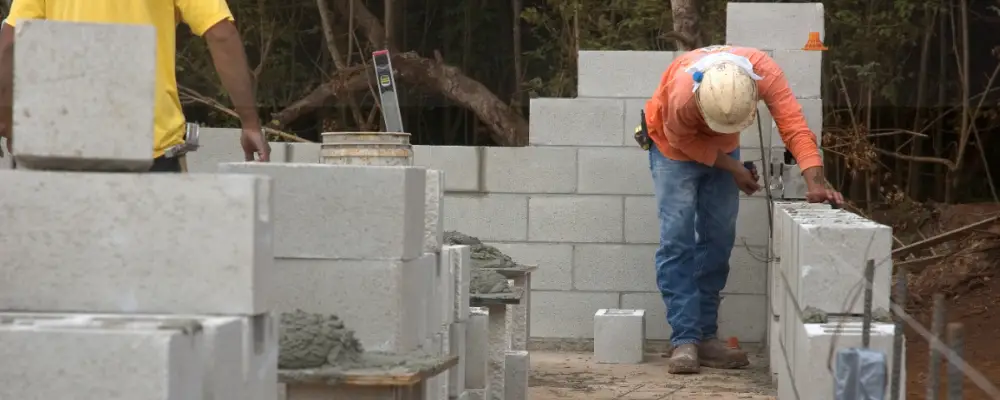Building a new wall from the existing brick masonry, such as a house extension, garden walls and conservatories, is challenging. However, certain modern construction techniques could solve this problem. Among these techniques, toothing is one of the most commonly used and effective construction techniques in a masonry structure. Here we take a look at what toothing in brick masonry is.
What is Toothing in Brick Masonry?
Toothing is a construction technique where the walls are terminated with an opening or gap in the alternate course to help adjoining brick fit the wall surfaces without adjusting or cutting the brick. The toothing process is sometimes used for window and door openings to cut into an existing masonry wall, and a lintel is installed.
How Toothing Works in Brick Masonry
For Adjoining Walls

Toothing in brick masonry creates a mechanical bond by overlapping the bricks from the existing wall with bricks from adjacent walls. The overlocking bricks are then bonded with a mortar to create interlocking joints that secure the wall from movement and separation. This helps transfer the load from one wall to another, provides stability & resistance and prevents distortion.
For Window & Door Lintels

The tooth opening is also used when a window or door opening needs to be cut into an existing masonry wall. The lintel opening is cut and removed, and a lintel is placed in the alternate tooth openings. This improves load transfer from the window frame to the neighbouring walls, prevents water ingress, and enhances durability.
Toothing Process in Brick Masonry
- Preliminary checks on the existing wall should be done to ensure that the area where the wall needs to be intersected is clear of debris and obstructions.
- Cut and remove the bricks at the opening in an alternate course to create the toothing.
- In case of a window or door opening,
- Place the lintel in the tooth opening.
- Insert the half-bricks back into the tooth to create a jamb flush for installing the window or door.
- Apply mortar to the toothing bricks and ensure the window lintels are securely bonded with the existing wall.
- For building a new wall from the existing wall,
- Lay the mortar bed on the surface and place the bricks overlapping the toothing bricks to create a strong bond.
- Using the same size bricks as the existing wall is important for proper bonding.
- Continue laying and interlocking with the tooth of the existing brickwork.
- Point the joints between the bricks using mortar and finish the wall surface.
When & Where is Toothing Used?
When to use toothing?
- Toothing in brick masonry is most commonly used to connect an adjacent wall with an existing one to create a strong bond between them.
- This is used for adding an extension to an existing wall.
- To install a window or door opening in the existing wall.
- Repairing damaged or cracked walls by reconnecting separated sections.
- To build curved or angled walls with strong bonding.
Where to use toothing?
- Toothing can be used at external corners to create a strong bond between two adjoining walls.
- In the case of a load-bearing wall, the toothing can be done in internal corners to distribute the load to adjoining walls.
- It is used around wall openings near doors, windows and arches to create a strong bond with the surrounding bricks.
- Toothing can be done at the junction of the wall, where the wall meets a column or a pier.
- Toothing can be done to structures in seismic areas to help the existing walls resist lateral seismic forces.
- It is also used in walls that need to withstand high wind loads.
Pros & Cons of Toothing in Brick Masonry
Pros
- Toothing creates a strong bond between the old and new walls, enhancing structural integrity.
- It provides the necessary resistance against lateral forces acting on the wall to reduce the risk of damage or potential collapse.
- It helps distribute the loads evenly on the walls, reducing the risk of cracks and damage and increasing the structure’s durability.
- A proper toothing process results in visually appealing joints between the walls.
- Reconnecting separate sections in the openings can repair damages and cracks in the walls.
- Properly executed toothings act as a reinforcement, supporting the structure in resisting external forces.
- It plays a major role in constructing angular walls with strong bonding.
Cons
- Filling joints adequately and achieving the proper bond is very difficult in toothing.
- It requires high quality labour, as the masonry works need exceptional skill to ensure the joints are properly packed for the full depth.
- It is a time-consuming process.
- Improperly executed toothing can reduce the structural strength and make structures prone to damage & leaks.
- It is not suitable for all types of bricks used in the masonry.
- Repairing or making changes after the execution of the toothing process is difficult.
Conclusion
Toothing in construction is creating a small projection on alternate courses along the edges for future wall extension or placing window or door openings. It provides seamless bonding between the new and existing walls and helps the structure enhance its structural integrity. However, this process is complex, time-consuming, and difficult, and it is difficult to provide a fully compacted joint below the toothing.

